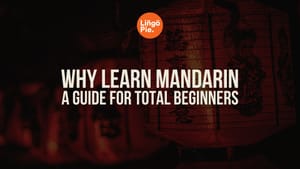When most people think of Mandarin Chinese, they picture a single, uniform way of speaking. In reality, Mandarin is spoken by over a billion people across different countries and communities, which means it naturally comes with a wide range of accents.
In this post, I’ll walk you through five of the most common Mandarin accents that you’re likely to hear. You’ll get a sense of where they’re spoken, what makes them unique, and why understanding these differences can make learning Chinese more fun and rewarding.
- 6 Best Taiwan Dramas On Netflix For Learning Mandarin Chinese
- 9 Chinese Jokes That Made Me Feel Fluent In Chinese
- 20+ Chinese Curse Words And Meanings Explained

What Is Mandarin Chinese & Where Is It Spoken?
Mandarin Chinese, known as Putonghua in Mainland China, is the official state language and is based on the Beijing dialect. It is one of the four official languages of Singapore, the official language of Taiwan, and one of the six official languages of the United Nations. Mandarin uses standardized grammar and vocabulary, but pronunciation and intonation can shift depending on the region.
It is spoken by more than a billion people, primarily in northern and southwestern China, and by Chinese communities worldwide. Beyond Mainland China, large populations in Taiwan, Singapore, Malaysia, and Hong Kong use Mandarin alongside local dialects or other languages. This wide reach explains why accents develop, as speakers blend Mandarin with the sounds and rhythms of their regional or native languages.
The Most Common Mandarin Chinese Accents
Mandarin may be one language, but it doesn’t sound the same everywhere. The way people speak is shaped by local history, culture, and other languages in their environment. This creates noticeable differences in pronunciation, rhythm, and even word choice.
Below are five of the most common Mandarin Chinese accents you’ll encounter.
| Accent | Example Word/Phrase | How It’s Pronounced / Notable Feature |
|---|---|---|
| Standard Chinese (Putonghua) | 北京 (Běijīng, “Beijing”) | Clear retroflex: “zh” in jīng is crisp; -r endings often added in casual speech (hǎor for hǎo). |
| Hong Kong Chinese | 北京 (Běijīng) | Retroflex softened: “jīng” may sound closer to zīng; -r endings usually dropped. |
| Taiwanese Chinese | 这里 (zhèli, “here”) | Retroflex zh often sounds like z → pronounced zèli; erhua endings rarely used. |
| Singaporean Chinese | 吃饭 (chī fàn, “eat rice/meal”) | chī may lose retroflex, sounding like cī; rhythm influenced by English/Malay phrasing. |
| Malaysian Chinese | 明天 (míngtiān, “tomorrow”) | Final “-n” may shift toward “-ng,” sounding like míngtiang; tone slightly flatter, with local slang often added in casual speech. |
Standard Chinese Accent
The Standard Chinese accent is the official form of Mandarin in Mainland China. It is primarily based on the Beijing dialect but blends features from other northern varieties.
Some of the key traits of this Chinese accent includes clear distinctions between retroflex and alveolar consonants (like zh/ch/sh vs. z/c/s), frequent use of the retroflex “-r” ending (erhua), and reliance on neutral tones.
Examples:
- 孩子 (háizi) → neutral tone on zi
- 好 (hǎo) → hǎor (with -r ending)
- 一点儿 (yìdiǎnr) is common instead of just yìdiǎn
Hong Kong Chinese Accent
When Hong Kong speakers use Mandarin, their accent often reflects strong Cantonese influence. Common features include limited use of the “-r” ending, tonal adjustments that differ from standard Mandarin, and sound substitutions such as pronouncing “ng” as “n.”
Examples:
- 忙 (máng, “busy”) → may sound like mán
- 一点儿 (yìdiǎnr) → usually said as yìdiǎn
Taiwanese Chinese Accent
Mandarin in Taiwan is marked by a softer, more melodic sound compared to northern accents. Influenced by Taiwanese Hokkien, it often merges retroflex and alveolar consonants (so zh/ch/sh may sound like z/c/s), reduces or avoids erhua endings, and uses vocabulary unique to Taiwan.
Examples:
- zhōngguó (“China”) → sounds closer to zōngguó
- 一点儿 (yìdiǎnr) → yìdiǎn (no -r)
Singaporean Chinese Accent
The Singaporean Mandarin accent has been shaped by the country’s multilingual environment, where Hokkien, Teochew, Cantonese, Malay, and English all play important roles. As a result, pronunciation may merge retroflex and alveolar sounds, tones can shift, and sentence phrasing sometimes mirrors English or Malay.
Examples:
- zhīdao (“know”) → may sound closer to zīdào
- Ending particles like lah, leh, meh added for emphasis
Malaysian Chinese Accent
Malaysian Mandarin is influenced by heritage dialects like Hokkien, Cantonese, and Hakka, as well as Malay and English. Speakers may produce slight vowel shifts, use distinctive tonal patterns, and mix in local slang or borrowed words. Like Singaporean Mandarin, it merges features of multiple languages, but its sound and rhythm are uniquely Malaysian.
Examples:
- shí (“ten”) → may sound like sher
- guō (“pot”) → may sound like wo
Why Learning About These Accents Matters
Learning Mandarin accents is more than just an interesting detail. It can make a real difference in how well you understand and connect with speakers from different regions.
- Real-world comprehension: People don’t all speak with the standard accent taught in classrooms. Being familiar with variations makes conversations easier to follow.
- Travel and work readiness: Whether in Taiwan, Singapore, or Hong Kong, accents shift. Knowing what to expect helps in daily life and professional settings.
- Cultural awareness: Accents reflect local history and identity. Recognizing them shows respect and makes interactions warmer.
- Confidence building: Instead of feeling lost when hearing a new rhythm or tone, you’ll be prepared to understand and respond naturally.
Learn Chinese With Lingopie
The best way to truly understand Mandarin accents is to hear them in action. Textbooks usually focus on Standard Mandarin, but real conversations sound different depending on where the speaker is from. With Lingopie, you can watch authentic TV shows, movies, and series from China and Taiwan giving you natural exposure to the way people actually speak.
Lingopie makes it easy to follow along with dual subtitles, pick up new vocabulary, and notice accent differences in real time. By practicing with real voices, you’ll train your ear to understand Mandarin as it’s spoken across different regions. It’s a fun, flexible way to build confidence and experience the language as a living, global conversation.
Want to give Lingopie a try? Sign up for a FREE trial below!
Frequently Asked Questions
1. Is Mandarin the same in every country?
No. While the written language is standardized, the spoken form changes depending on the region. Mandarin spoken in Beijing, Taipei, Singapore, or Kuala Lumpur will sound different because of local influences.
2. Which Mandarin accent should I learn first?
If you’re a beginner, it’s best to start with Standard Mandarin (Putonghua). It’s the official version taught worldwide, used in Chinese media, and understood by the largest number of speakers.
3. Are all these accents mutually understandable?
Yes. Mandarin accents may sound different, but they are generally mutually intelligible. You might need time to adjust your ear to new tones, rhythms, or vocabulary.
4. Why do Taiwanese and Mainland Mandarin sound so different?
Taiwanese Mandarin has been shaped by Hokkien and a different cultural history, giving it a softer rhythm and distinct vocabulary. Mainland Mandarin, especially from Beijing, emphasizes retroflex sounds and uses -r endings.
5. Do Singaporean and Malaysian Mandarin sound the same?
They share similarities because both are influenced by southern Chinese dialects, Malay, and English. However, Malaysian Mandarin tends to have more vowel shifts and intonation patterns distinct to Malaysia.
6. Will learning accents make me fluent faster?
Learning accents won’t necessarily make you fluent faster, but it will improve your listening skills and help you adapt to real-world conversations with speakers from different backgrounds.




![Korean Aegyo: Korean Words And Gestures To Look And Sound Cute [2025]](/blog/content/images/2025/10/Korean-agyeo.png)
![Do Belgians Speak French? A Guide To Belgian French [2025]](/blog/content/images/size/w1200/2025/10/Do-belgians-speak-french.png)
![9 Funny Chinese Proverbs That’ll Brighten Your Day [Guide]](/blog/content/images/size/w300/2025/12/Funny-Chinese-Proverbs.jpg)


![11/11 Singles’ Day in China: What Is It And How Is It Celebrated [Guide]](/blog/content/images/size/w300/2025/11/Singles-day-in-china.jpg)